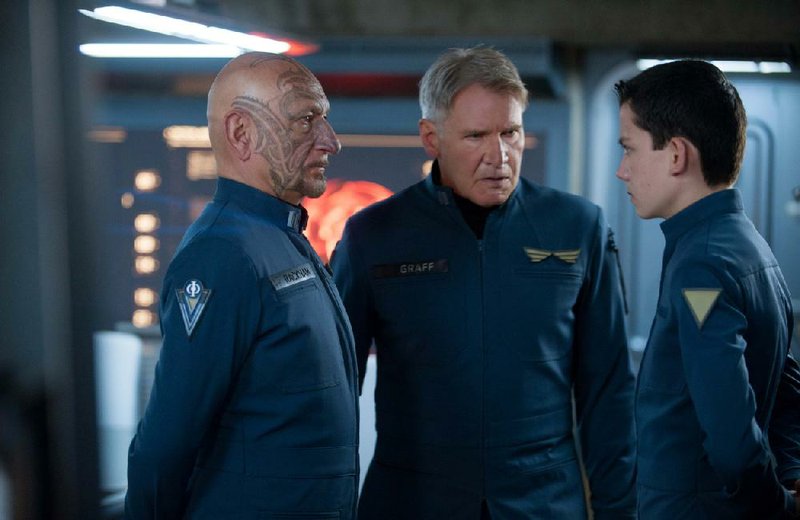LOS ANGELES - Harrison Ford looks perplexed and a bit pained when asked about his reputation as a film icon.
“‘Icon’ means nothing to me,” says the actor, who gained that label by creating indelible characters such as Han Solo in Star Wars and the adventurous archaeologist in Raiders of the Lost Ark. “It seems like a word of convenience.
I don’t know what an icon does except stand in a corner and accept attention. I like to work and continue to grow and be useful to a story.” Asa Butterfield, who co-stars with 71-year-old Ford in futuristic thriller Ender’s Game, sees it differently. “I was pretty nervous about meeting Harrison Ford,” admits the British actor who plays 12-year-old Ender Wiggin, a protege of Ford’s Col. Hyrum Graff. “It turned out that we got on pretty well. He brought out the best in us.”
Butterfield, 16, is referring to the adolescent actors in the film who portray clever strategists selected to attend Earth-orbiting Battle School. They’re there to sort out the best and brightest to lead an international military force in a to-the-death battle against an insectlike alien race that nearly destroyed Earth 50 years ago and is about to try again.
The role of Ender is crucial to the film, says director Gavin Hood. “We auditioned [for Ender] all over the world, knowing that the emotional demands on that young lead were enormous. Not all could deliver against Harrison Ford. But Asa could.”
Ender’s Game was shot in sequence, Hood says, “because, for one thing, Asa [2011’s Hugo] grew two inches during the shoot. And his confidence in working with an icon [that word again!] like Harrison Ford also grew, which was necessary for some of the highly emotional scenes.”
Ford’s process for selecting a film involves a good story and good character. “I read the [Ender’s Game] script before the book and found an interesting subject and character that I hadn’t seen in a film before,” he says. “It’s a really good family movie with themes of individual responsibilities and leadership capabilities. This is a strange situation - a world government meeting the threat of an alien invasion, not one country trying to control another.”
Regarding his young colleague’s trepidation about working with an actor of Ford’s renown and experience, “Asa was cast before I was,” Ford points out. “He is an accomplished actor with a wonderful talent and work ethic.”
Despite getting along fine, the two held each other at arm’s length throughout the shoot, which took place at a former NASA assembly facility in New Orleans. “Harrison and I kept an essence of our characters’ confrontational relationship going on off-screen to maintain the tension,” Butterfield says.
The opportunity to return to outer space in Ender’s Game wasn’t a deciding factor for Ford. “I look for whether I can identify the utility of a character,” he says. “I like the process of giving what is on a sheet of paper life and shape.”
The methods used in interstellar filmmaking are quite different from Han Solo’s days of zipping around in Star Wars’ Millennium Falcon. “Techniques to create visual elements have changed tremendously,” Ford says. “Star Wars used plastic models on sticks moving past the camera. Computer effects make the job easier but can generate such a busy canvas that the audience doesn’t know where to look, and you lose touch with the human character. You have to be careful that effects don’t overpower the story.”
Ender’s Game wasn’t shot in 3-D, which may seem curious given its wealth of sweeping video gamelike sequences. “3-D works best with foreground, midground and background,” Hood says. “It doesn’t work with deep space. Spaceships end up looking like little toys.”
The biggest challenge of the film, Hood says, was coming up with an adaptation of the book written in 1985 by Orson Scott Card. “It’s tricky in that it is a very internal story, all about thinking and feeling. Translating that into a film isn’t always easy. Actors reflect emotion, which is difficult in some ways and easier in others. You can get a great deal of information from an actor in a reaction shot.”
Ender has to take responsibility for his moral choices, he continues. “In that sense it’s a beautiful coming-of-age story, a film for young people that doesn’t talk down to them. Our hope is that it can generate a conversation between parents and kids while being highly entertaining.”
Along with attending space camp and training with members of Cirque du Soleil on how to work with wires for the film’s many scenes in a weightless environment, Butterfield faced one more challenge.
“It was the first time I used an American accent,” he says. “I had someone working with me and learned to develop an accent for the words on the page, which eventually led to knowing the sounds. It helped to be surrounded with crew and cast from the States - even in Louisiana, with that Southern drawl.”
MovieStyle, Pages 33 on 11/01/2013
